Samali (Σάμαλι)
Samali is a Greek cake made with semolina, Greek yogourt, orange juice, sugar and it is flavoured with masticha (mastic). This uniquely prepared cake is baked and then an aromatic orange flavoured syrup is poured over top.
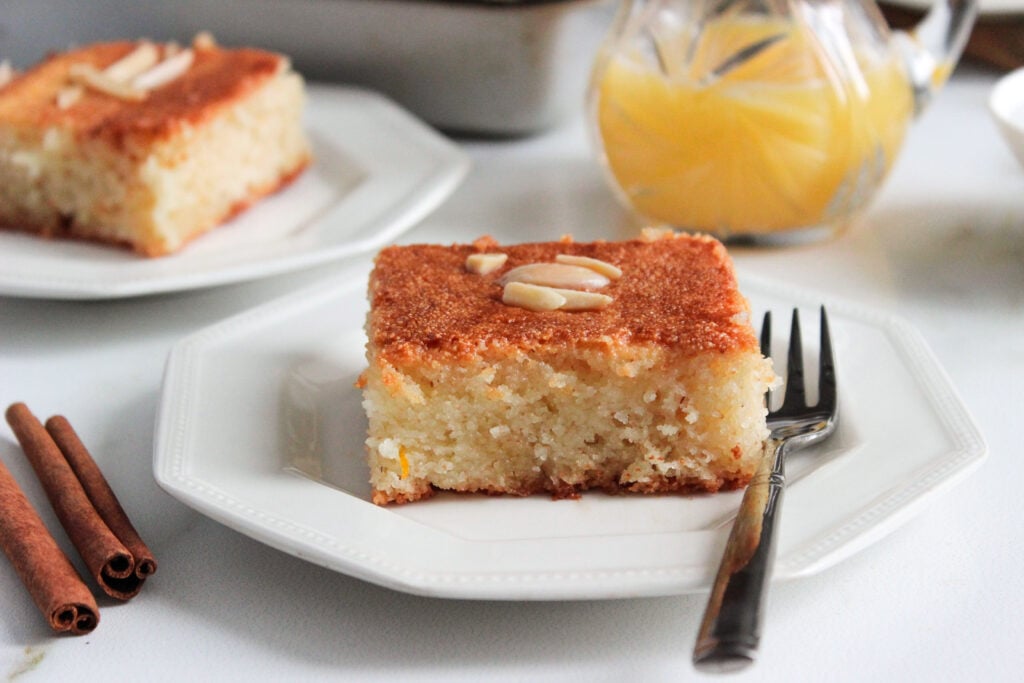
Growing up in a Greek home my parents made a wide variety of syrup soaked desserts. Greeks love sweet and sticky desserts. In fact, there is an entire class of sweets in Greek cooking called siropiasta, which translates to syrupy or syrup-soaked. There are many ways to get your syrup on! You can enjoy traditional Greek pastries like galaktoboureko or baklava or lesser known cakes like portokalopita and revani. These sweets are very popular and loved all over Greece. One of the lesser known siropiasta is samali, but I think it may actually be one of my favourites.
What is samali?
Samali (Σάμαλι), pronounced with the accent on the first syllable, is a lovely and not too popular syrup cake. This traditional Greek cake uses semolina instead of flour and Greek yogourt in lieu of eggs, fat, or other dairy. The flavour of masticha is traditional. Although you can omit the masticha, every effort should be made to find this uniquely flavoured plant resin, obtained from the mastic tree. Don’t worry, it’s not that difficult to find since you can order mastic here.
Why I love this recipe
I absolutely love the unique way that samali is made. It produces the most unique and lovely texture. I also enjoy the flavour of masticha which makes this cake very special.
Samali is sweet, but not too sweet, and it is the perfect accompaniment to a nice Greek coffee or a Frappé.
I also love that when I serve it, many people have never had it before, and I love the look of delight on their faces when they try it for the very first time.
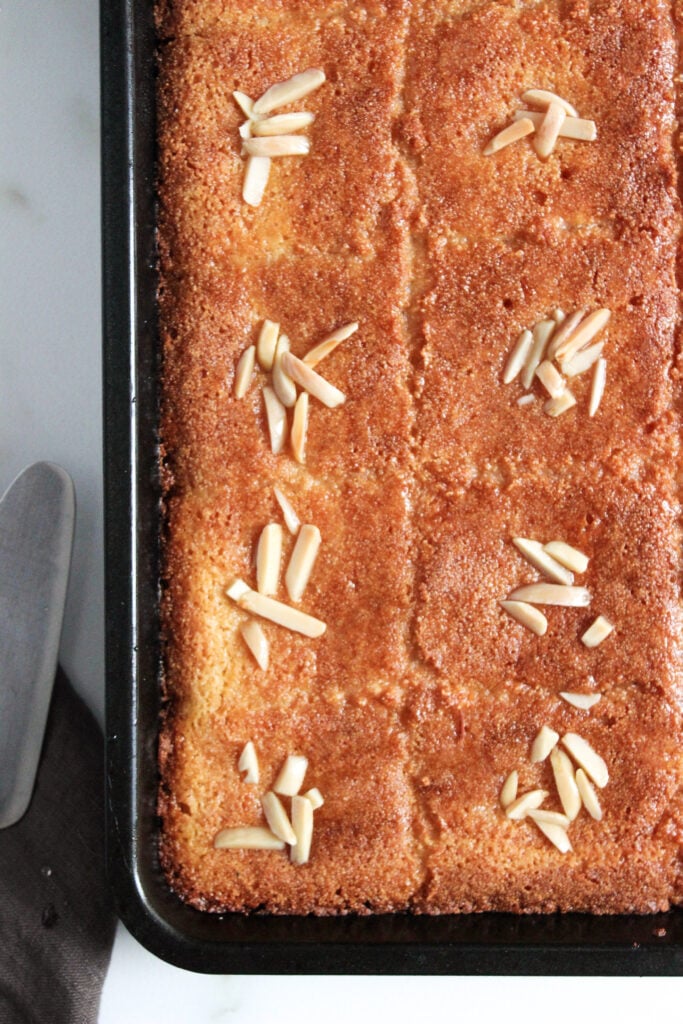
Key ingredients
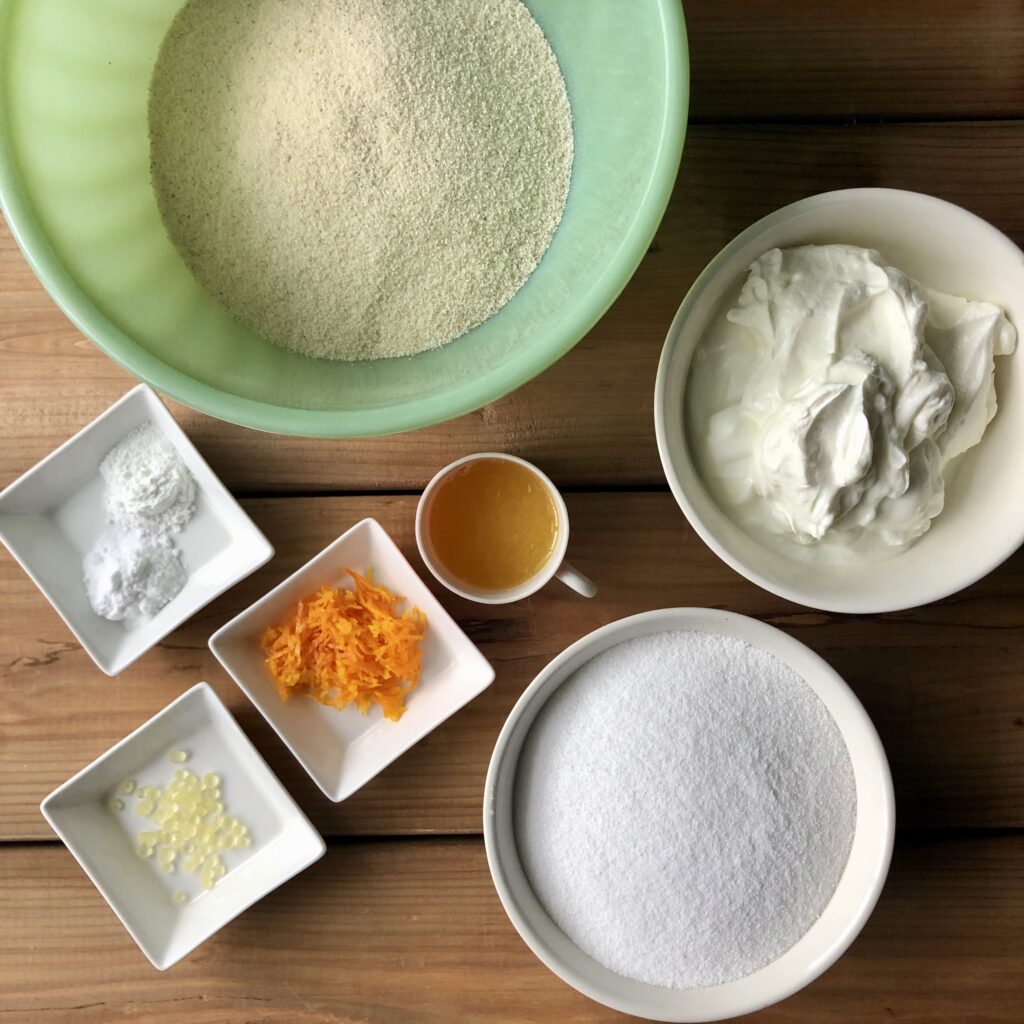
Coarse semolina Semolina flour is made from durum wheat, which is the hardest variety of wheat. It has a high protein and gluten content and is pretty resistant to milling. You can get fine or coarse semolina; coarse semolina has a somewhat grittier texture than the fine version, but even the latter will not be as fine as regular flour. In samali the coarse semolina is part of what gives the cake a unique texture.
Baking powder & baking soda Both of these are used together as leavening agents for the cake.
Greek yogourt I use plain, full fat Greek yogourt when I make my samali. The yogourt provides the fat content to the cake, making it rich and creamy.
Superfine sugar I never purchase superfine sugar actually, because it can be hard to find, and when you do it tends to be pretty pricey. What I do instead is take regular granulated sugar and blend it up in a blender or food processor until it resembles a fine white powder. Using superfine sugar in the samali is lovely because you want to make sure that it dissolves completely in the cake.
Masticha (mastic powder) This is a very unique and special ingredient, a plant resin that comes from the mastic tree found on the island of Chios, Greece. Although it can be omitted, I really recommend that you try to find it. Fortunately, mastic powder is available online. It offers such a unique and lovely flavour to baked goods, one that really can’t be replaced with anything else.
Orange juice I like to use freshly squeezed orange juice because nothing beats the flavour!
Grated orange rind When grating the rind of your orange be sure not to include the white pith layer which can be bitter. My favourite tool for grating citrus is my microplane grater – it does such a great job, and is easy to use.
Vegetable oil I like the mild flavour of vegetable oil and the moisture that oil gives the cake.
Slivered almonds This is optional, but I really like decorating the top of my dessert with slivered almonds. They add a decorative touch and crunch that is quite nice.
For the syrup
Water Regular tap water or filtered water is fine here.
Sugar I use regular granulated sugar for the syrup because it will dissolve well in the boiling water.
Cinnamon stick. Typically when I add cinnamon to a syrup I use cinnamon sticks. This way I get the flavour of the cinnamon, without changing the colour of the syrup.
Orange juice Freshly squeezed juice is used to give the syrup a great orange flavour.
Orange peel I add orange peel because the oils of the orange (found in the peel) really have an intense orange flavour. I am careful not to include the white part of the peel however because this can impart a bitter taste.
How to make samali
The lovely flavour of the mastic is not the only unique thing about this cake. Samali is a dessert that you assemble, and then let sit for a few hours before baking it. This is to allow the semolina to soak up any liquid from the yogourt and orange juice. When the cake then gets baked, you end up with a crispy and toasty texture. Just lovely!
Step 1 – Make the syrup
Combine all of the syrup ingredients into a small pot and bring to a boil. Reduce heat to a simmer until the sugar dissolves then cook for an additional 5 minutes. Remove from heat and set aside, covered.
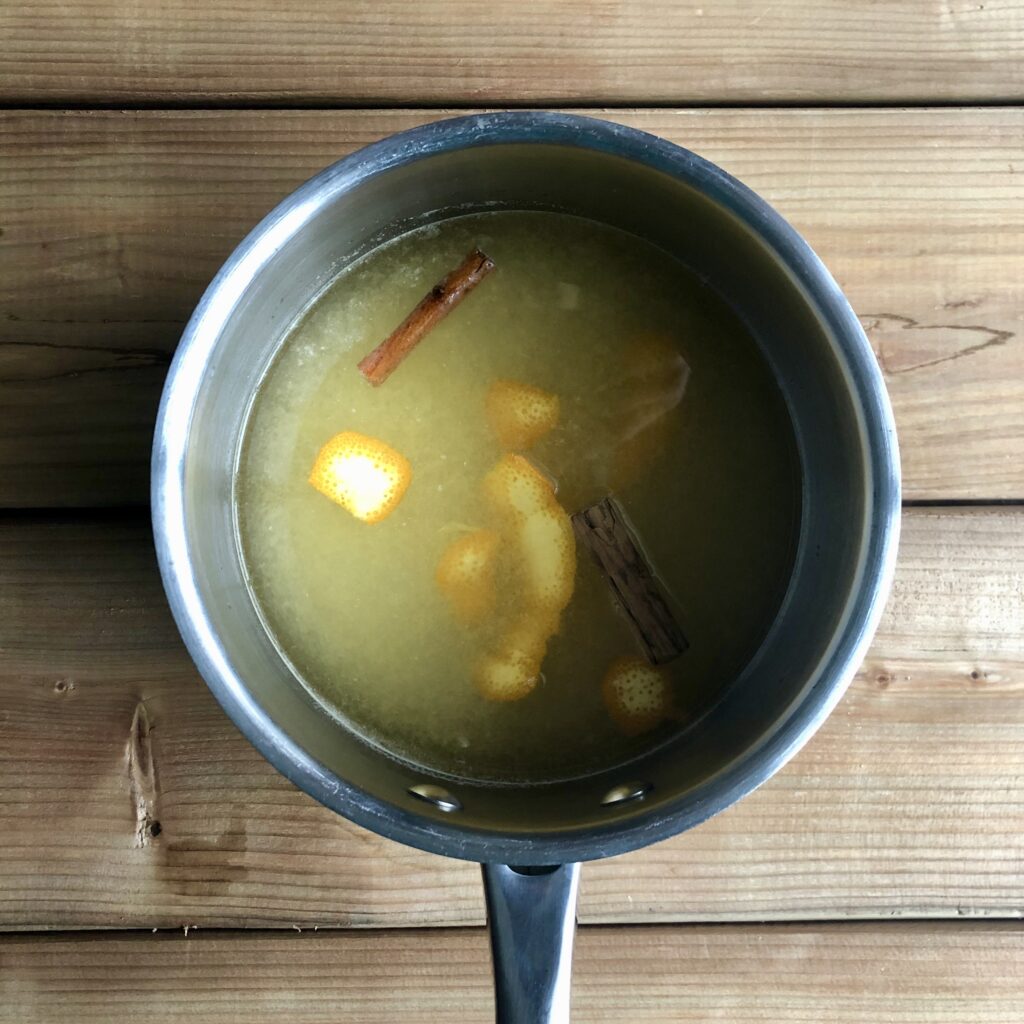
Step 2 – Make the cake
In a large mixing bowl combine the semolina, baking powder, baking soda, and mix until well combined. Using a stand mixer fitted with the paddle attachment or a plastic spatula incorporate the rest of the ingredients (except for the slivered almonds) and mix well until everything is well combined.
Step 3 – Prepare the pan
Lightly grease a 8 x 10 inch rectangular baking pan and pour in the batter ensuring even distribution.
Step 4 – Allow to rest
Cover the cake batter with plastic wrap and set aside at room temperature for at least 2 hours or until the cake appears dry (the liquid has been absorbed).
Step 5 – Prepare for baking
Preheat your oven to 350 degrees Fahrenheit. While your oven is coming to temperature, use a sharp knife to score your samali into your serving pieces. Top each piece with a slivered almond, if using.
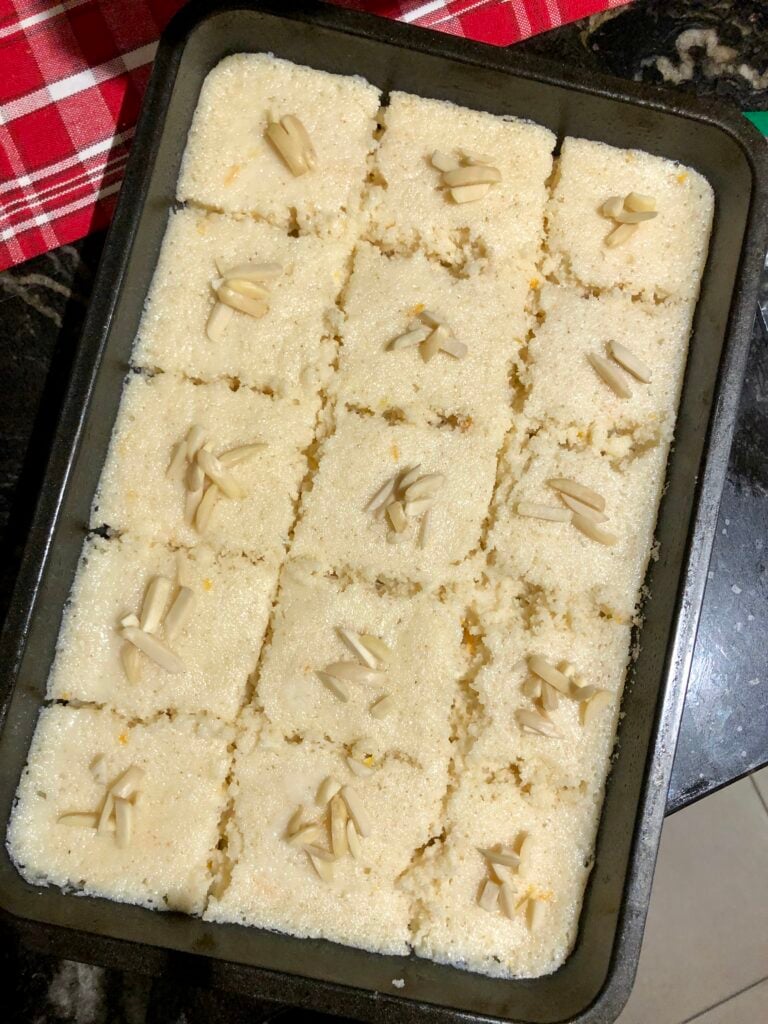
Step 6 – Bake
Bake, uncovered, in the middle rack of your oven for approximately 30 minutes or until golden brown.
Step 7 – Add syrup
Remove from oven and immediately pour on the cooled syrup, being sure to distribute it evenly.
Step 8 – Hold on! You have to wait!
You should allow the samali to rest for at least 30 minutes before serving!
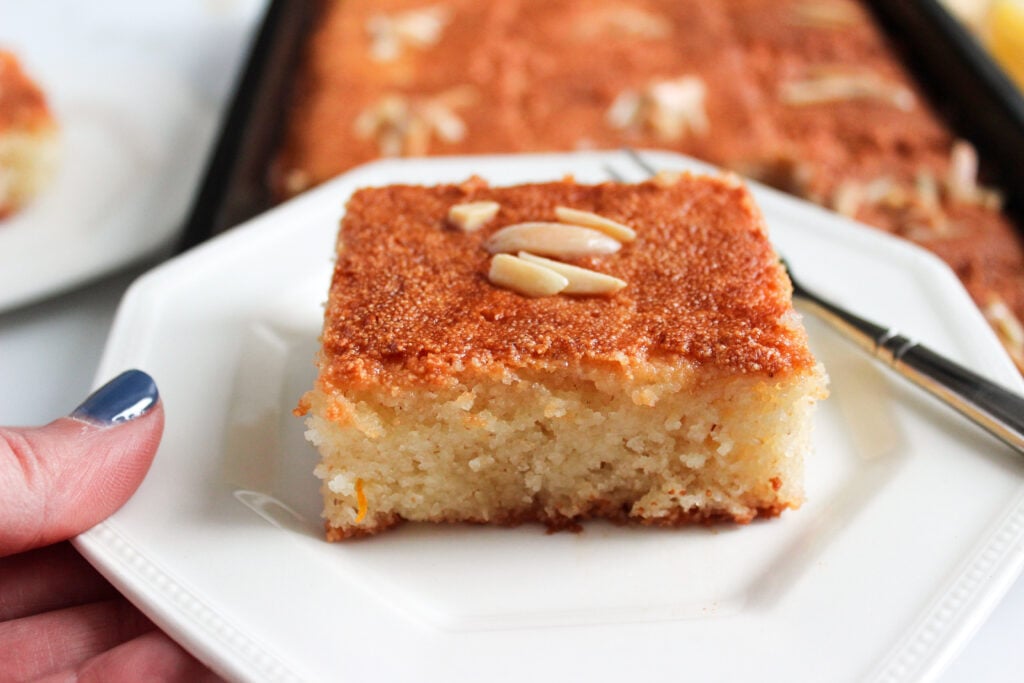
Baking tips and helpful hints
When grating your orange, and peeling it for use in the recipe be careful to avoid the white layer right under the peel. This tends to be bitter, and can affect the taste of your dessert.
You can purchase your masticha already ground up, or in chunks. Whenever possible I like to buy it in chunks which I then grind myself; this helps ensure that it is as fresh as possible. When I grind my masticha crystals I use a mortar and pestle which I line with parchment paper to make clean-up easier. Remember that masticha is a tree resin, and tends to get very sticky. If you do end up with a sticky mess that is hard to clean, place your dirty container (whatever it may be) in the freezer and then chip off the frozen bits of resin using a butter knife.
Whether you purchase masticha powder or masticha crystals, I keep them in the refrigerator. This keeps them fresher longer, but also helps when grinding up the crystals.
I make my own superfine sugar by blending or processing regular white granulated sugar in a blender or a food processor.
Watch video on how to make samali
Recipe substitutions
I like to use full-fat Greek yogourt in my recipe but you can use reduced fat yogourt if you prefer.
Instead of vegetable oil you can use another mild flavoured oil. You can also use olive oil (either entirely, or in part). Just keep in mind that the flavour and colour of your cake will be altered.
Although this recipe calls for coarse semolina, you can also use the finer semolina. The texture of your samali will be different, but it will work out just fine. I love to use the Clic brand of semolina (available in Canada and the United States), but you can definitely use what you prefer and have easily available.
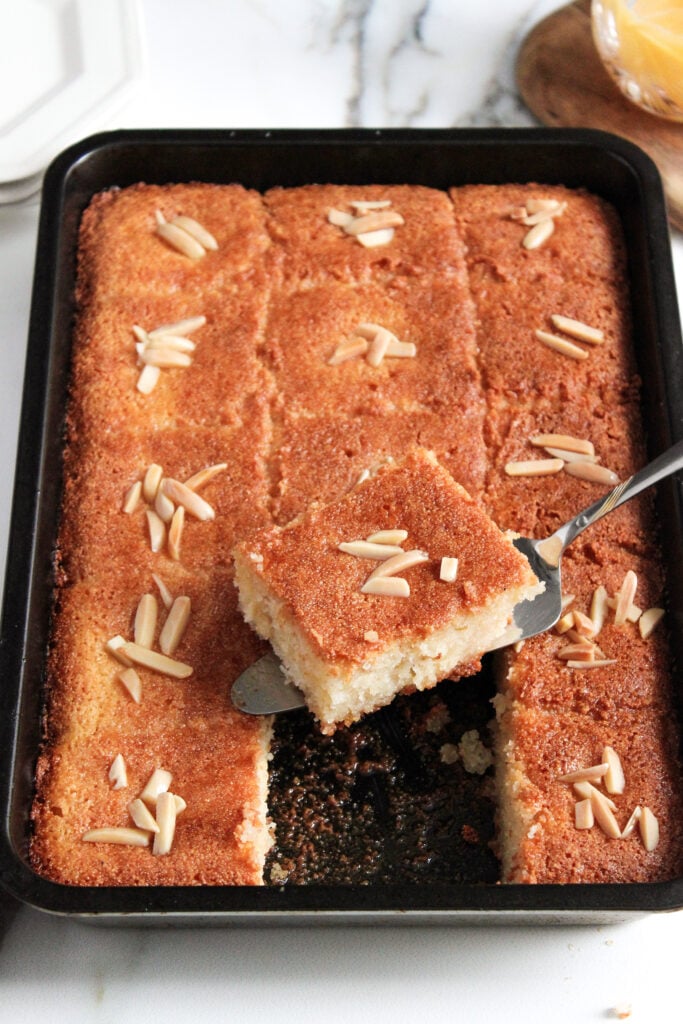
Recipe variations
You can make lemon flavoured samali. Simply replace the orange juice, orange zest and orange peel with that of lemon. Otherwise, the recipe remains the same.
Related recipes
Love samali and looking for some more siropiasta desserts? You’ve come to the right place!
Pantespani Light, fluffy and flavoured with orange – a basic sponge cake soaked in syrup
Karydopita Classic Greek walnut cake soaked in a sweet and sticky syrup
Ravani A delicious cake made with semolina and coconut
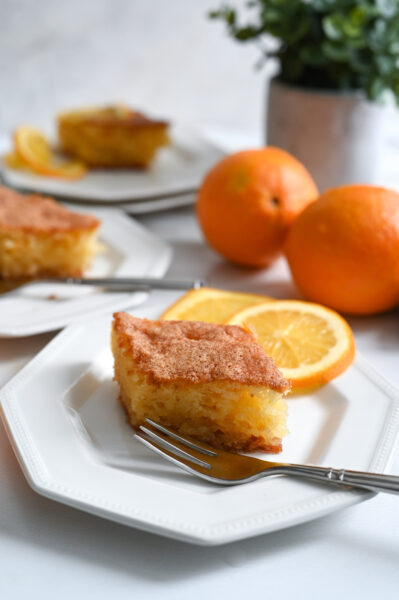
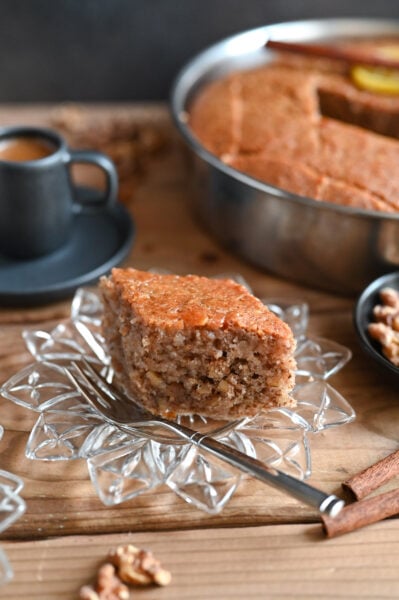
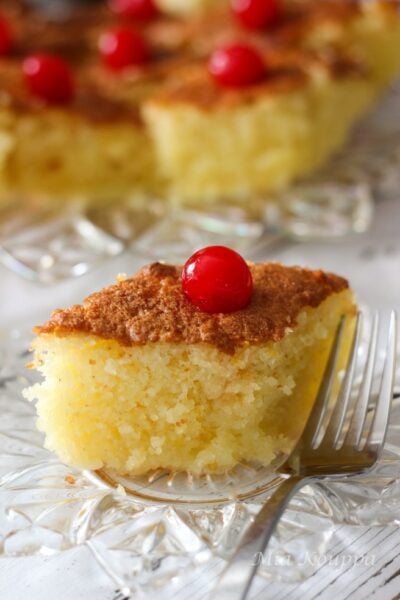
Watch us below make Greek revani with coconut!
Pin this recipe if you like it.
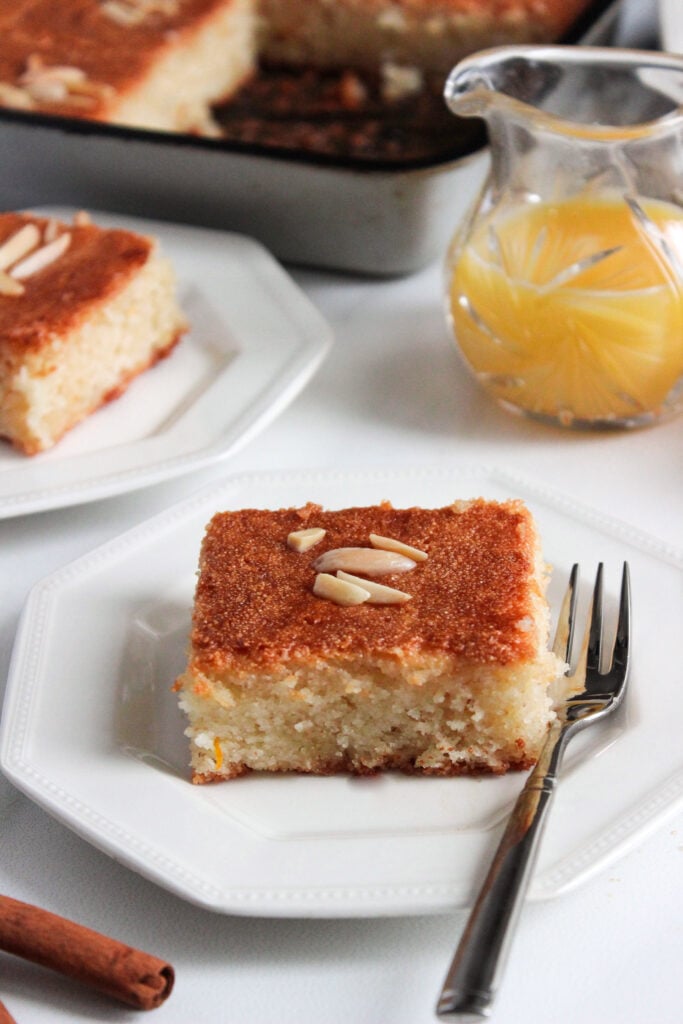

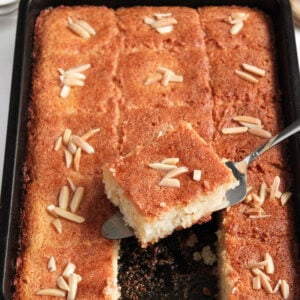
Samali (Σάμαλι)
Equipment
- 1 8 x 10 inch baking pan
Ingredients
For the cake
- 2 cups coarse semolina
- 1 tsp baking powder
- 1 tsp baking soda
- 1 ¼ cups Greek yogourt, plain
- 1 ⅓ cups superfine sugar see Recipe Note
- 1/2 tsp ground masticha (mastic powder) see Recipe Note
- 1/4 cup orange juice, freshly squeezed
- 1 tbsp grated orange rind
- vegetable oil for lightly coating baking pan
- slivered almonds for decorating cake
For the syrup
- 1 1/2 cup water
- 1 cup granulated sugar
- 1 cinnamon stick
- 1/4 cup orange juice, freshly squeezed
- orange peel, white pith removed
Instructions
For the syrup
- Combine all of the syrup ingredients into a small pot and bring to a boil. Reduce heat to a simmer until the sugar dissolves. Cook for another 5 minutes. Remove from heat and set aside, covered.1 1/2 cup water, 1 cup granulated sugar, 1 cinnamon stick, orange peel, white pith removed, 1/4 cup orange juice, freshly squeezed
For the cake
- In a large mixing bowl combine the semolina, baking powder, baking soda, and mix until well combined. Using a stand mixer fitted with the paddle attachment or a plastic spatula incorporate the rest of the ingredients and mix well until everything is well combined.2 cups coarse semolina, 1 tsp baking powder, 1 tsp baking soda, 1 ¼ cups Greek yogourt, plain, 1 ⅓ cups superfine sugar, 1/2 tsp ground masticha (mastic powder), 1/4 cup orange juice, freshly squeezed, 1 tbsp grated orange rind
- Lightly grease a 8 x 10 inch rectangular baking pan and pour in the batter ensuring even distribution.vegetable oil for lightly coating baking pan
- Cover with plastic wrap and set aside for at least 2 hours or until the cake appears dry (the liquid has been absorbed).
- Preheat your oven to 350 degrees Fahrenheit.
- Use a sharp knife to score your samali into your serving pieces. Top each piece with a slivered almond.slivered almonds
- Bake, uncovered, in the middle rack of your oven for approximately 30 minutes or until golden brown.
- Remove from oven and immediately pour on the cooled syrup, being sure to distribute it evenly.
- Allow to rest for approximately 30 minutes before serving.
- Enjoy!

Love semolina!!! And i espeically love syrupy desserts!! I can’t wait to try this! I have lots of oranges in season, looking forward to using them in this dessert.
Thank you for this recipe! I still remember the smell at my grandmother’s house in Greece❤
You’re so welcome!! We’re happy to be able to bring back some fond memories 🙂
Samali is a wonderfully simple cake to prepare that is also rich in flavor. The semolina and yogurt in this cake gives it a great texture, and the syrup is filled with flavor.
Yes, isn’t it a great cake!! Love everything about samali! 🙂
Love your recipes–they are easy to read and user friendly. One comment, would it be possible to list the calories, fat, sugar, content for each recipe?
Thanks,
sp
Hi Shirley, thanks so much for your message. We’re so glad you’re enjoying our recipes. This is something that we are really interested in doing; we do have to upgrade one of programs; and hopefully, we can get this up and running sooner then later 🙂
Wow! Your Sambali recipe is really good and delicious. Some recipe releasers include ‘farina’, ‘flour’ and destroy Semolina cake.
Thank you for the recipe.
You’re so welcome!! Glad you enjoyed our recipe 🙂 xox Helen & Billie
Its delicious. Wondering if cornmeal be substituted for semolina in this recipe to make it gluten free? Some of our guests are on gluten free diets.
Thanks
Hi Cathy! Thank you, and thanks for your question. Having not made that substitution ourselves, we can’t be certain how it would turn out. In theory a 1:1 substitution should work though! Otherwise, we do have some naturally gluten-free desserts on our site that you might want to try, like our amygdalota cookies or our honey tahini cookies. Enjoy! xoxo Helen & Billie
Love your recipes, for the Samali, instead of yogurt can we sub for milk?
Thank you
Hi Jane! Thanks so much! We are thrilled that you enjoy our recipes 🙂 Substituting milk for the yogourt in our samali recipe might work – honestly, we have never tried it so can’t be sure. Let us know if you give it a try, and how it works xoxo Helen & Billie